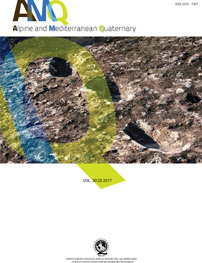The morphology of the base of the alluvial sediments of the Vercelli plain (Piedmont, NW Italy): an integration of the knowledge on the quaternary geological evolution
Main Article Content
Abstract
The southern Vercelli Plain lies on the top of the westernmost Apennine thrust front (Monferrato thrust front). According to previous studies, it is interested by Quaternary tectonics and, despite the absence of historical earthquakes, could be affected by ML 6 earthquakes. However the lack of Middle Pleistocene river sediments and terraces in the southern part of the plain prevents any knowledge of the geological evolution for a period that lasted about 600-700 ka and limits the data useful to establish the seismo-tectonic characteristics of the Monferrato thrust front and to establish the seismic hazard. Using the data derived from studies carried out in the 70s and 80s of the 20th century in order to localize a nuclear power plant, including field surveys, the drilling of dozens of boreholes, geophysical surveys, and hydrogeological studies of superficial waters and aquifers, and also data on the base of the unconfined aquifer, it has been possible to evidence the morphological features of the surface that lies at the base of the alluvial sediments. The data indicate that in the southern Vercelli Plain there are small valleys and ridges covered by alluvial sediments, originated by erosion connected with the Alpine rivers and local streams, that do not show any evidence. The pattern of the buried ridges and valleys appears to be influenced by tectonic movements along faults that, only in part, correspond to the Monferrato thrust front and transverse deformation zones active until the Middle Pleistocene. Only for a small area, the buried drainage network flowed towards a karst system developed in Messinian gypsum.
Article Details
Issue
Section

This work is licensed under a Creative Commons Attribution-NonCommercial-NoDerivatives 4.0 International License.
The Author grants usage rights to others using an open license (Creative Commons or equivalent) allowing for immediate free access to the work and permitting any user to read, download, copy, distribute, print, search, or link to the full texts of articles, crawl them for indexing, pass them as data to software, or use them for any other lawful purpose.

